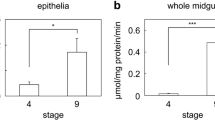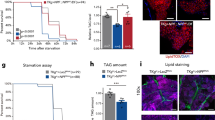Abstract
Trehalose is a non-reducing disaccharide comprising two glucose molecules. It is present in high concentration as the main haemolymph (blood) sugar in insects. The synthesis of trehalose in the fat body (an organ analogous in function to a combination of liver and adipose tissue in vertebrates) is stimulated by neuropeptides (hypertrehalosaemic hormones), released from the corpora cardiaca, a neurohaemal organ associated with the brain. The peptides cause a decrease in the content of fructose 2,6-bisphosphate in fat body cells. Fructose 2,6-bisphosphate, acting synergistically with AMP, is a potent activator of the glycolytic enzyme 6-phosphofructokinase-1 and a strong inhibitor of the gluconeogenic enzyme fructose 1,6-bisphosphatase. This indicates that fructose 2,6-bisphosphate is a key metabolic signal in the regulation of trehalose synthesis in insects. Trehalose is hydrolysed by trehalase (E.C. 3.2.1.28). The activity of this enzyme is regulated in flight muscle, but the mechanism by which this is achieved is unknown. Trehalase from locust, flight muscle is a glycoprotein bound to membranes of the microsomal fraction. The enzyme can be activated by detergents in vitro and by short flight intervals in vivo, which indicates that changes in the membrane environment modulate trehalase activity under physiological conditions.
Similar content being viewed by others
References
Azuma, M., and Yamashita, O., Cellular localization and proposed function of midgut trehalase in the silkworm larva,Bombyx mori. Tissue & Cell17 (1985) 539–551.
Azuma, M., and Yamashita, O., Immunohistochemical and biochemical localization of trehalase in developing ovaries of the silkworm,Bombyx mori, Insect Biochem.15 (1985)589–596.
Beenakkers, A. M. Th., Van der Horst, D. J., and Van Marrewijk, W. J. A., Biochemical processes directed to flight muscle metabolism, in: Comprehensive Insect Physiology, Biochemistry and Pharmacology, vol. 10, pp. 451–486. Eds. G. A. Kerkut and L. I. Gilbert. Pergamon Press, Oxford 1984.
Berthelot, M., Sur le tréhalose nouvelle espèce de sucre. C. r. hebd. Séanc. Acad. Sci., Paris46 (1858) 1276–1279.
Bowers, W. S., and Friedman, S., Mobilization of fat body glycogen by an extract of corpus cardiacum. Nature198 (1963) 685.
Brandt, N. R., and Huber, R. E., The localization of honey bee thorax trehalase. Can. J. Biochem.57 (1979) 145–154.
Cabib, E., and Leloir, L. F., The biosynthesis of trehalose phosphate. J. biol. Chem.231 (1958) 259–275.
Candy, D. J., The control of muscle trehalase activity during locust flight. Biochem. Soc. Trans.2 (1974) 1107–1109.
Candy, D. J., and Kilby, B. A., Site and mode of trehalose biosynthesis in the locust. Nature183 (1959) 1594–1595.
Candy, D. J., and Kilby, B. A., The biosynthesis of trehalose in the locust fat body. Biochem. J.78 (1961) 531–536.
Chino, H., Conversion of glycogen to sorbitol and glycerol in the diapause egg of theBombyx silkworm. Nature180 (1957) 606–607.
Clements, A. N., Page, J., Borck, K., and Van Ooyen, A. J. J., Trehalases from the flesh flySarcophaga barbata. J. Insect Physiol.16 (1970) 1389–1404.
Duve, H., Intracellular localization of trehalase in thoracic muscle of the blowfly,Calliphora erythrocephala. Insect Biochem.5 (1975) 299–311.
Gäde, G., The hypertrehalosaemic peptides of cockroaches: a phylogenetic study. Gen. comp. Endocrinol75 (1989) 287–300.
Gäde, G., The adipokinetic hormone/red pigment-concentrating hormone peptide family: structures, interrelationships and functions. J. Insect Physiol.36 (1990) 1–12.
Gäde, G., and Rinehart, K. L. Jr., Amino acid sequence of a hypertrehalosaemic neuropeptide from the corpus cardiacum of the cockroachNauphoeta cinerea. Biochem. biophys. Res. Comm.141 (1986) 774–781.
Gilby, A. R., Wyatt, S. S., and Wyatt, G. R., Trehalases from the cockroach,Blaberus discoidalis: Activation, solubilization and properties of the muscle enzyme and some properties of the intestinal enzyme. Acta Biochim. Pol.14 (1967) 83–100.
Gussin, A. E. S., and Wyatt, G. R., Membrane-bound trehalase from cecropia silkmoth muscle. Arch. Biochem. Biophys.112 (1965) 626–634.
Hasegawa, K., The diapause hormone of the silkworm,Bombyx mori. Nature179 (1957) 1300–1301.
Hasegawa, K., and Yamashita, O., Studies on the mode of action of the diapause hormone in the silkworm,Bombyx mori. VI-The target organ of the diapause hormone. J. exp. Biol.43 (1965) 271–277.
Hayes, T. K., Keeley, L. L., and Knight, D. W., Insect hypertrehalosemic hormone: isolation and primary structure fromBlaberus discoidalis cockroaches. Biochem. biophys. Res. Comm.140 (1986) 674–678.
Ikeda, M., Su, Z., Saito, H., Imai, K., Yukihiro, S., Isobe, M., and Yamashita, O., Induction of embryonic diapause and stimulation of ovary trehalase activity in the silkworm,Bombyx mori, by synthetic diapause hormone. J. Insect Physiol.39 (1993) 889–895.
Jutsum, A. R., and Goldsworthy, G. J., Fuels for flight inLocusta. J. Insect Physiol.22 (1976) 243–249.
Kammer, A. E., and Heinrich, B., Insect flight metabolism. Adv. Insect Physiol.13 (1978) 133–228.
Kono, Y., Takahashi, M., Matsushita, K., Nishina, M., Kameda, Y., and Hori, E., Inhibition of flight inPeriplaneta americana (Linn.) by a trehalase inhibitor, Validoxylamine A. J. Insect Physiol.40 (1994) 455–461.
Lee, Y.-H., and Keeley, L. L., Intracellular transduction of trehalose synthesis by hypertrehalosemic hormone in the fat body of the tropical cockroach,Blaberus discoidalis. Insect Biochem. molec. Biol.24 (1994) 473–480.
Mansingh, A., Studies on insect dormancy. II-Relationship of cold-hardiness to diapause and quiescence in the eastern tent caterpillar,Malacosoma americanum (Fab.), (Lasiocampidae: Lepidoptera). Can. J. Zool.52 (1974) 629–637.
Mayer, R. J., and Candy, D. J., Changes in energy reserves during flight of the desert locust,Schistocerca gregaria. Comp. Biochem. Physiol.31 (1969) 409–418.
McClure, J. B., and Steele, J. E., The role of extracellular calcium in hormonal activation of glycogen phosphorylase in cockroach fat body. Insect Biochem.11 (1981) 605–613.
McDougall, G. E., and Steele, J. E., Free fatty acids as a source of energy for trehalose synthesis in the fat body of the American cockroach (Periplaneta americana). Insect Biochem.18 (1988) 591–597.
Orr, G. L., Gole, J. W. D., Jahagirdar, A. P., Downer, R. G. H., and Steele, J. E., Cyclic AMP does not mediate the action of synthetic hypertrehalosaemic peptides from the corpus cardiacum ofPeriplaneta americana. Insect Biochem.15 (1985) 703–709.
Pilkis, S. J., (Ed.), Fructose-2,6-bisphosphate. CRC Press, Boca Raton, Florida 1990.
Reed, W. D., and Sacktor, B., Localization of trehalase in flight muscle of the blowflyPhormia regina. Arch. Biochem. Biophys.145 (1971) 392–401.
Randall, D. D., and Derr, R. F., Trehalose: occurrence and relation to egg diapause and active transport in the differential grasshopper,Melanoplus differentialis. J. Insect Physiol.1 (1965) 329–335.
Scarborough, R. M., Jamieson, G. C., Kalish, F., Kramer, S. J., McEnroe, G. A., Miller, C. A., and Schooley, D. A., Isolation and primary structure of two peptides with cardioacceleratory and hyperglycemic activity from the corpora cardiaca ofPeriplaneta americana. Proc. natl Acad Sci.81 (1984) 5575–5579.
Shimada, S., and Yamashita, O., Trehalose absorption related with trehalase in developing ovaries of the silkworm,Bombyx mori. J. comp. Physiol.131 (1979) 333–339.
Steele, J. E., Occurrence of a hyperglycemic factor in the corpus cardiacum of an insect. Nature192 (1961) 680–681.
Steele, J. E., McDougall, G. E., and Shadwick, R., Trehalose efflux from cockroach fat bodyin vitro: paradoxical effects of the corpus cardiacum and methylxanthines. Insect Biochem.18 (1988) 585–590.
Su, Z., Ikeda, M., Sato, Y., Saito, H., Imai, K., Isobe, M., and Yamashita, O., Molecular characterization of ovary trehalase of the silkworm,Bombyx mori and its transcriptional activation by diapause hormone. Biochim. biophys. Acta1218 (1994) 366–374.
Takesue, Y., Yokota, K., Nishi, Y., Taguchi, R., and Ikezawa, H., Solubilization of trehalase from rabbit renal and intestinal burshborder membranes by a phosphatidylinositolspecific phospholipase C. FEBS Lett.201 (1986) 5–8.
Terra, W. R., and Ferreira, C., Insect digestive enzymes: properties, compartmentalization and function. Comp. Biochem. Physiol.109B (1994) 1–62.
Vaandrager, S. H., Haller, T. B., Van Marrewijk, W. J. A., and Beenakkers, A. M. Th., Fractionation and kinetic properties of trehalase from flight muscles and haemolymph of the locust,Locusta migratoria. Insect Biochem.19 (1989) 89–94.
Van der Horst, D. J., Van Doorn, J. M., and Beenakkers, A. M. Th., Dynamics in the haemolymph trehalose pool during flight of the locustLocusta migratoria. Insect Biochem.8 (1978) 413–416.
Van Laere, A., Trehalose, reserve and/or stress metabolite? FEMS Microbiol. Rev.63 (1989) 201–210.
Van Schaftingen, E., Role of fructose-2,6-bisphosphate in the regulation of hepatic carbohydrate metabolism, in: Fructose-2,6-bisphosphate, pp. 65–85. Ed. S. J. Pilkis. CRC Press, Boca Raton, Florida 1990.
Van Schaftingen, E., Hue, L., and Hers, H.-G., Fructose 2,6-bisphosphate, the probable structure of the glucose- and glucagon-sensitive stimulator of phosphofructokinase. Biochem. J.192 (1980) 897–901.
Wegener, G., Elite invertebrate athletes: flight in insects its metabolic requirements and regulation and its effects on life span, in: International Perspectives in Exercise Physiology, pp. 83–87. Eds. K. Nazar, R. L. Terjung, H. Kaciuba-Uscilko and L. Budhoski. Human Kinetics Books, Champaign, Illinois 1990.
Weis-Fogh, T., Fat combustion and metabolic rate of flying locusts (Schistocerca gregaria Forskal), Phil. Trans. Roy. Soc. Lond.B237 (1952) 1–36.
Wiens, A. W., and Gilbert, L. I., Regulation of cockroach fat body metabolism by the corpus cardiacumin vitro. Science150 (1965) 614–616.
Wiens, A. W., and Gilbert, L. I., Regulation of carbohydrate mobilization and utilization inLeucophaea maderae. J. Insect Physiol.13 (1967) 779–794.
Worm, R. A. A., Characterization of trehalase from locust flight muscle. Comp. biochem. Physiol.70B (1981) 509–514.
Wyatt, G. R., The biochemistry of sugars and polysaccharides in insects. Adv. Insect. Physiol.4 (1967) 287–360.
Yamashita, O., and Suzuki, K., Roles of morphogenetic hormones in embryonic diapause, in: Morphogenic Hormones in Arthropods pp. 82–128. Ed. A. P. Gupta. Rutgers University Press, New Brunswick 1991.
Zebe, E. C., and McShan, W. H., Trehalase in the thoracic muscles of the woodroach,Leucophaea maderae. J. cell. comp. Physiol.53 (1959) 21–29.
Author information
Authors and Affiliations
Rights and permissions
About this article
Cite this article
Becker, A., Schlöder, P., Steele, J.E. et al. The regulation of trehalose metabolism in insects. Experientia 52, 433–439 (1996). https://doi.org/10.1007/BF01919312
Issue Date:
DOI: https://doi.org/10.1007/BF01919312




